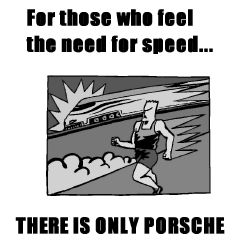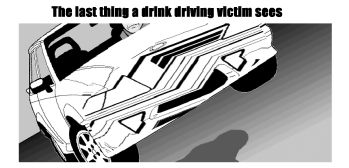Pictures and images
A large proportion of advertisements include an image of some kind. Sometimes it’s a drawing, sometimes it’s a photo. Whatever it is, it’s been included in the advertisement for a reason. Your job in writing your analysis is to understand what the image is all about.
Advertisements can include literal, metaphorical, or situational images. A literal image might show a photo of the actual product being advertised. A metaphorical image for a new car might show a man sprinting at full speed with an exhilarated expression on his face.

The image conveys a feeling of speed - something Porsches have traditionally been associated with. The copywriters are trying to draw the connection between Porsche and speed, without blatantly putting a picture of a Porsche right in front of your face.
Situational images usually show a familiar situation, which you may have experienced yourself or seen happen. An advertisement for a refreshing drink might show a person lifting their shoe just as they realise that they’ve stepped in doggie doo. The caption could read something like, "For those moments in life...drink CalmCola™". The copywriters are trying to get a response of familiarity from you, something like, "Oh yeah, that happened to me the other day".
Another thing to analyse is the type of image used in the advertisement. A cartoon might be used in an ad for a non-serious product or service, whereas a sober, high-quality black and white image might be used in an ad for a more serious or formal product or service. For instance, a cartoon might be used in an advertisement for chocolate. A black and white image might be used in a funeral parlour advertisement.
If there are people in the image, think about their body language and facial expressions. If the image is a photo (or a TV advertisement), think about what camera angles have been used and to what effect. An anti-drink driving ad might show a road from the point of view of a pedestrian victim who has just been hit by a car driven by a drunk driver. The camera might be placed at the level of the bitumen at an odd angle, looking towards the dented bumper of the car, and showing a pool of blood gradually seeping onto the bitumen. The skewed angle of the camera is used to portray that the pedestrian is injured or just about to die. Traditionally movies and TV shows have used a camera angle skewed wildly to represent the perspective of a person falling down as they lose consciousness.

Click here to move on to the next topic: More complicated messages